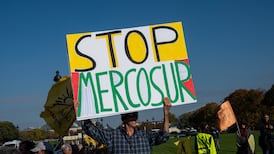Home ownership levels continued to decline in Dublin and across the country in the first six months of the year, despite the introduction of the Help to Buy scheme in January 2017. They have now hit a record national low.
A demand side measure with the ultimate aim of boosting supply and enabling first-time buyers purchase a home, the scheme, which offers a tax rebate of up to 5 per cent on the purchase price of a new house, was launched to much fanfare in January 2017.
With pent-up supply, the scheme got off to a strong start, and as of the end of October there have been more than 11,000 applications from first-time buyers, some 4,500 of which have been claimed successfully.
However, despite the measure, home ownership levels continue to fall to record lows. Unpublished figures from the Central Statistics Office (drawn from the Quarterly National Household Survey) show that in the first six months of the year the percentage of people owning their own home, as opposed to renting, fell back from 60.8 per cent to 60.1 per cent in Dublin. The decline was more marked across the country.
New low
Nationally (excluding Dublin), home ownership figures fell from 73.3 per cent as of end 2016 to 72.1 per cent as of June 2017, as the number of people renting jumped from 15.3 per cent to 16.8 per cent. This means the national figure fell to 68.7 per cent as of June , 2017, down from 69.8 per cent as of year-end 2016, representing a new low for Irish home ownership.
The number of people owning their own home reached a peak at about 80.1 per cent in 1991, but has been declining since, in line with trends in other countries; in the UK home ownership is at a 30-year low of 64 per cent, the lowest figure seen since 1986.
While it’s still too early to indicate the overall impact of the scheme, it would appear to have had limited impact on boosting home ownership – meaning that pressure continues to mount on the rental sector.
Barely budged
The experience in the UK has been similar. A report from Bloomberg found that ownership rates for first-time buyers have barely budged since the UK’s Help to Buy initiative started in 2013, as it concluded that the scheme has mainly helped purchasers who were well-off enough to have afforded a house anyway. Nine per cent of buyers aided by the government earned more than £80,000 a year Bloomberg found. Figures for the Irish scheme would also suggest that the scheme may be helping people who would have bought anyway, rather than those who may be most in need of assistance.
Indeed as our analysis of the scheme shows, given that almost one in two purchases (47 per cent ) were for properties worth €301,000 or more, half of those people applying for the scheme must have incomes of € 85,714 or more, while about one in five will have joint incomes of € 107,000 or more.
Home ownership hasn’t increased with Help to Buy – it’s actually fallen (% of population)
| DUBLIN | 2016 (Q4) | 2017 |
| Owner occupied | 60.8 | 60.1 |
| Private rented | 24.8 | 24.3 |
| Other | 14.4 | 15.6 |
| NATIONAL (EXCLUDING DUBLIN) | 2016 (Q4) | 2017 |
| Owner occupied | 73.3 | 72.1 |
| Private rented | 15.3 | 16.8 |
| Other | 11.3 | 11.1 |
Source: CSO












